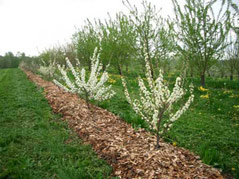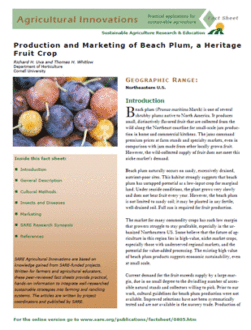Commercial production of beach plum is possible in the Northeastern U.S. using standard stone fruit production techniques. Beach plum does not thrive on poorly drained soils. Because beach plum is new to horticulture production, keeping records and photos of your practices and yields will help you develop a system that works on your farm. Beach plum has similar cultural requirements and pests to other commercially grown plums, although for pruning, peach may be a better model because like beach plum, peach fruit is not borne on spurs (short, fruiting shoots).

In cooperation with Barnstable County Cooperative Extension (U. Massachusetts), and local farmers, we installed an experimental orchard on Cape Cod, Massachusetts. Located at Coonamessett Farm, a community supported agriculture producer in Falmouth, MA, this beach plum planting has served as a research and demonstration facility since 1997. Wild-collected seed-grown beach plums were grown in an experiment with the treatments of mulch (4”woodchip), fertilizer (typical orchard rates) and irrigation (1 inch supplemental water/week). Growth and yield were greater in fertilized treatments. Within fertilized plots, irrigation and mulch did not increase growth or yield.
Propagation
Beach plum plants are available from several commercial and state conservation nurseries (Table 1). However, if you would like to produce plants from seed, the following procedures should be followed. Remember that seeds are living organisms and should not be exposed to extreme heat or prolonged soaking in oxygen-poor water. Collect the seeds after the fruit has fully ripened in September. Clean off all of the pulp and skin by rubbing the seed through a coarse screen. Seeds that float are dead and can be discarded. To store seeds, dry them at room temperature for several days. Seal them in an airtight jar and store in a refrigerator kept above freezing.
| Table 1. Suppliers of Large Quantities of Bareroot Beach Plum Stock | ||
| Nursery Name | Location | Telephone |
| J.G. Akerboom | Cedarville, NJ | 856-447-3346 |
| Princeton Nurseries | Allentown, NJ | 609-259-7671 |
| Concord Nurseries | North Collins, NY | 800-223-2211 |
| New Hampshire State Forest Nursery | Boscawen, NH | 603-796-2323 |
For the seeds to germinate, they must first undergo a process called pre-chilling (or stratification). This is a cold, moist period when chemical changes take place in the seed. During pre-chilling, store the seeds in moistened peat moss or sphagnum moss. The peat should not be soggy but about as damp as a well-wrung sponge. Mix the seeds thoroughly with the peat moss and store for at least four months in a refrigerator (approximately 40 degrees F), not the freezer. Check the seeds periodically. If roots have emerged, the seeds are ready to be planted. Germinated seed can be held safely at cold temperatures above freezing for some time. Plants obtained through seed propagation will show variation typical of wild plants. Select the largest, most vigorous plants for your planting.
Vegetative propagation is necessary if you want plants identical to the parent stock. Beach plums may be propagated either by semi-hardwood stem cuttings or by root cuttings. However, results with stem cuttings have been inconsistent and should probably be attempted only by experienced propagators.
Stem cuttings should be taken in the latter part of June when the developing fruit is approximately pea sized. Cuttings should be between 4 and 6 inches in length, taken from side shoots or non fruiting branches. Cuttings must be treated with a root inducing hormone. Rootone (NAA), Dip n Grow (IBA + NAA) or Hormodin (IBA) have all been used for rooting beach plums [2, 3].
Prepared cuttings should be stuck in sand or Perlite in flats and kept under mist or clear plastic sheeting until rooting occurs. At that point, the rooted cuttings should be transplanted into individual containers and misting should be reduced to harden off the cuttings to ambient conditions.
Beach plums may be propagated by root cuttings as well. Three- to four-inch root cuttings about the diameter of a pencil should be taken in late fall and placed horizontally in soil outside [1]. The propagation bed should be mulched with straw as the ground begins to freeze in the winter.
